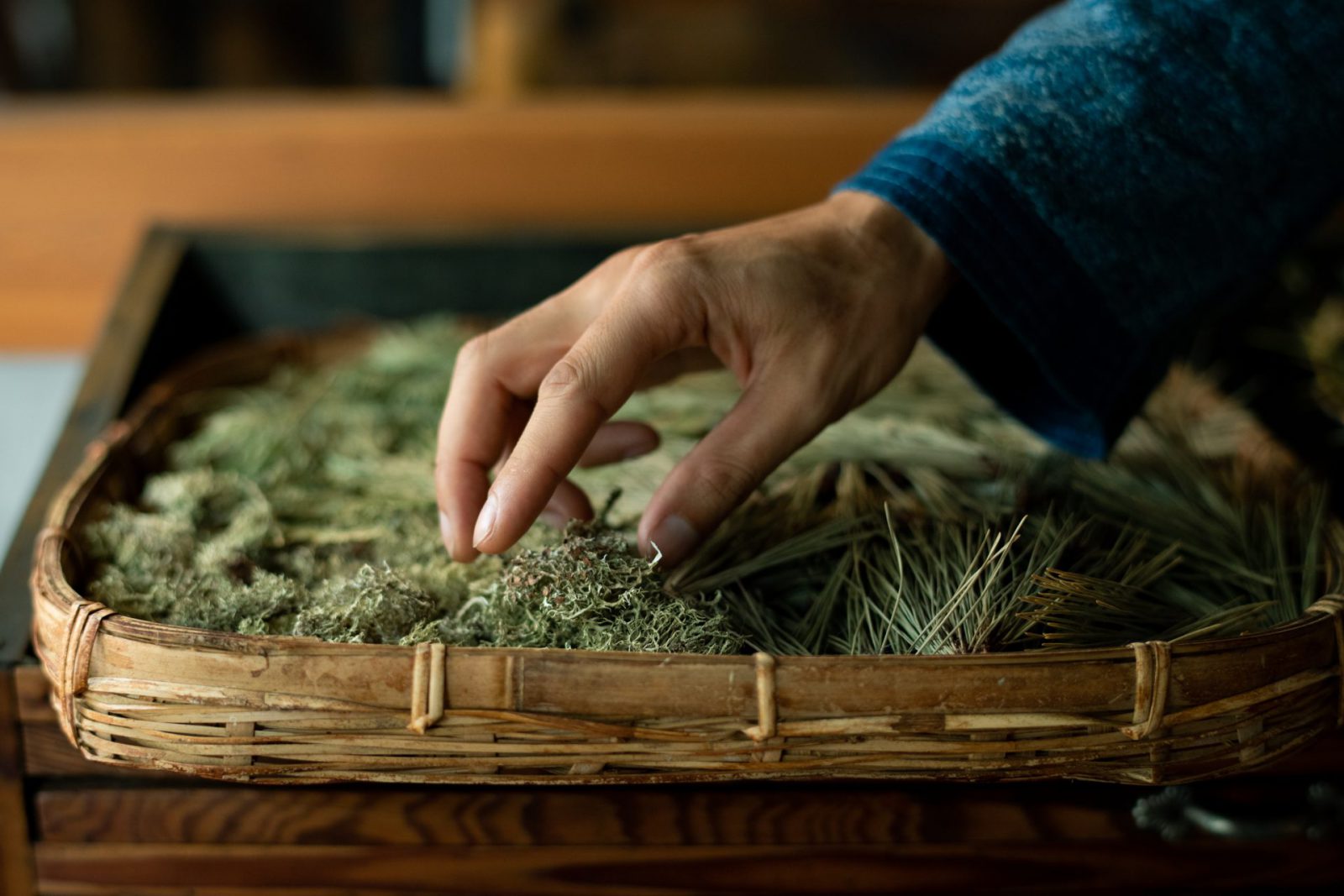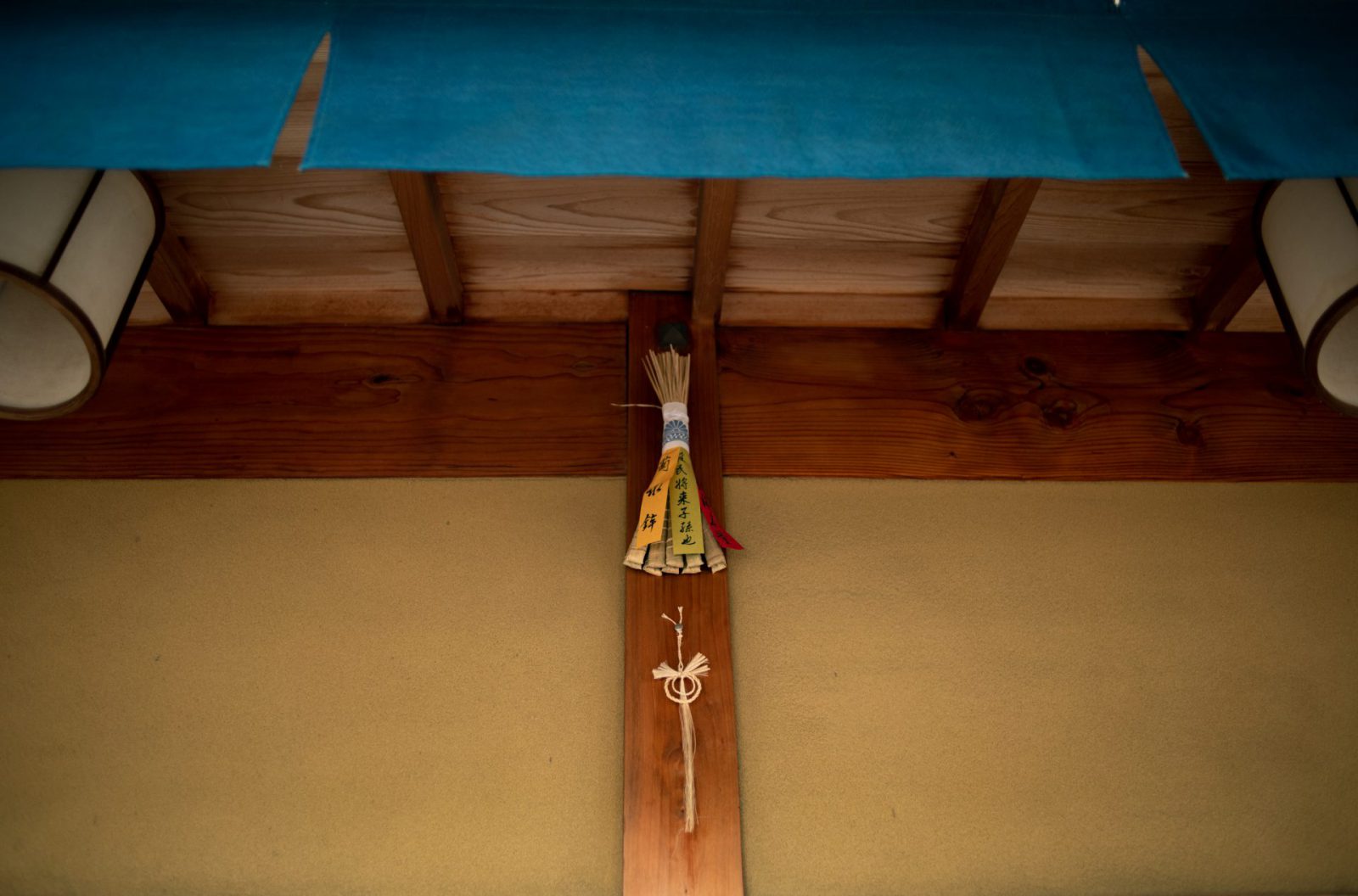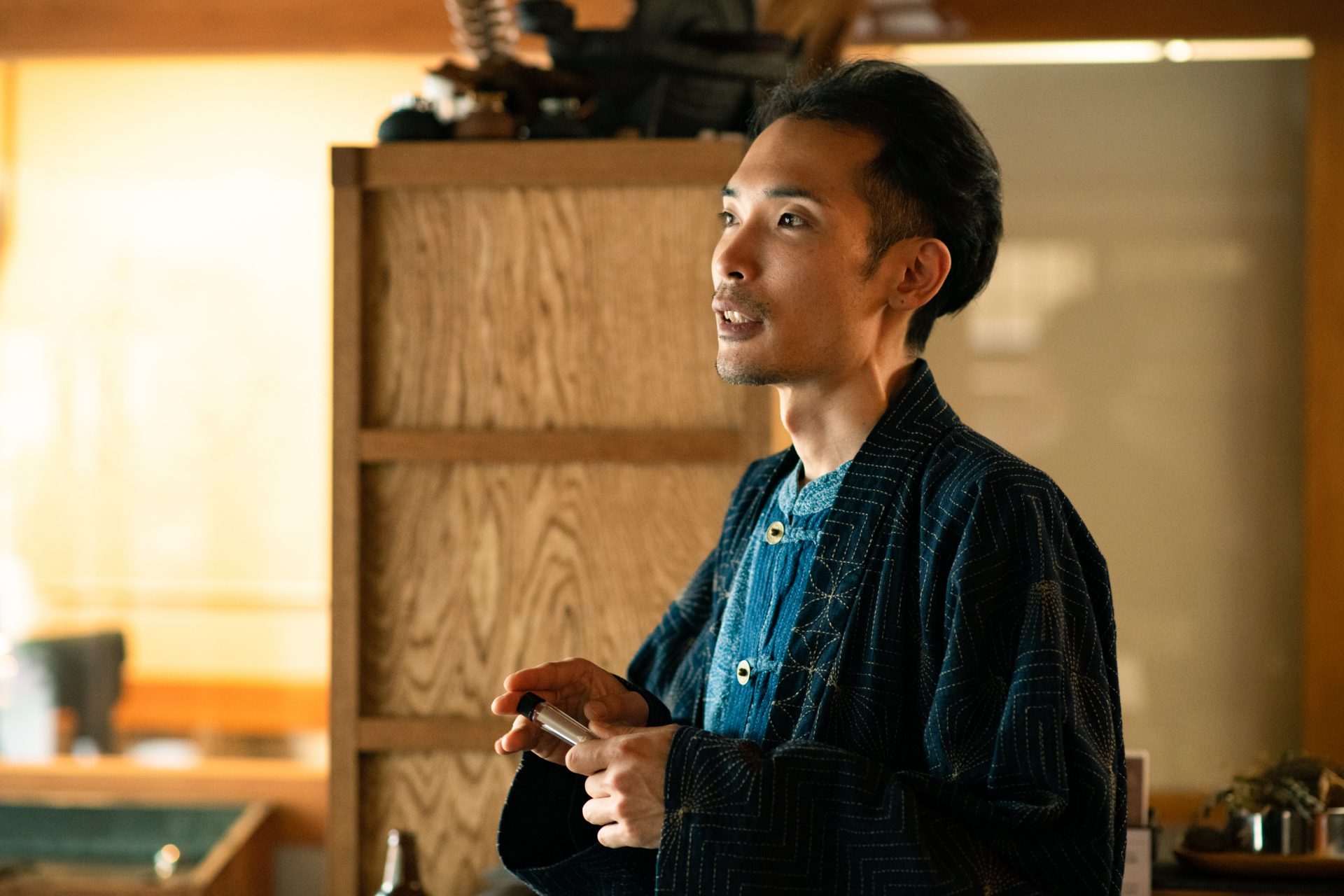“Everything found in nature has the potential of becoming an ingredient for fragrance. Whenever I look at nature, I see it in that kind of sensual way.”
It was late April when we traveled to the south area of the Kyoto Gosho, or the Kyoto Imperial Palace — the former ruling place of the emperor. The exterior of this shop has a historic and elegant look, but once we ducked under the noren (shop curtain), a mysterious other-worldly atmosphere filled the space.

The Sanga Incense & Fragrance Lab is located on Karasuma Street in Kyoto. The workshop and shop are adjoined and the inside is filled with rich and unique fragrances.
Shop owner Katsuhiro Hashimoto has been fascinated and inspired by the various fragrances he encountered during his travels.
He hand-collects various herbs, spices, aromatic woods, and minerals from around the world to create his own unique fragrances. His original stick incense, which he makes only out of natural materials, are garnering attention from both in and outside of Japan.
So how does he use “fragrance” to stimulate people’s hearts?

“Digging” and collecting fragrances from nature
Hashimoto’s fascination with fragrances began while he was traveling the world. He brought back the different fragrances he encountered to Japan, but back home, he faced a long period of time in which he struggled to obtain the ingredients.
“Nobody wanted to sell the ingredients in bulk to me because I had no name or reputation to back myself up. Since no one would sell to me, I decided to go gather the ingredients myself. I started looking for new fragrances as I picked and gathered in different countries. I realized then that if something can be found in nature and be made into a powder, anything can become an ingredient for fragrance.”
Whether he’s taking a walk or riding his bicycle around town, Hashimoto is always on the lookout for new fragrances hidden in our everyday lives.

“This is a collection of things that I gathered in the last six months. In herbal medicine, citrus peel is known as “Chenpi.” I was eating a tangerine when I thought that the peel can be turned into an ingredient for fragrance.”
“Digging” is a popular term in the music industry and describes the act of digging through and finding record albums in a music shop. Hashimoto uses the term to describe a similar act, but in the natural world.
Sometimes he finds ingredients by chance along the road, and other times he drives out in his car to go hunting for them. He draws inspiration from the looks of an object more than the way it smells.

“For example, if I find a tree that looks kind of cool, I stop the car and take a closer look. It may not have a nice scent initially, but it can develop a nice smell over time or once it’s seared. Sometimes it just doesn’t stand out on its own, and becomes a really nice background scent when it’s mixed with other ingredients. The fun of making fragrances is that you never know how things will turn out.”
“So I “dig,” mix, feel, think, try again, and repeat. Without the repetition, the fun doesn’t last”.

The functional beauty of Japanese stick incense
As Hashimoto traveled the world, he looked for incense that can be easily incorporated in the daily lives of people.
Lightly Searing aromatic wood, encasing ingredients in bamboo shafts, wrapping in paper — he tested all different types of incense. After repeated trial and error, he settled upon stick incense.

“There is a functional beauty to stick incense,” says Hashimoto.
“When lit, it releases a certain amount of smoke in a certain amount of time. The temperature of the burning area is about 300 to 400°C, and the area just below it burns at about 100°C. The steady and subtle is well suited for living quarters.”
While traditional Japanese stick incense burns for about 45 minutes, the Sanga incense is made to burn for 25 minutes. It is designed to have a shorter burning time.
“I thought about what is suitable for our current lifestyle. Considering that a regular living space is about 6 to 8 tatami mats, or 10 to15m², I calculated the most comfortable intensity of fragrance, density of smoke, and length of burn time. The average time a person can maintain their concentration is about 25 minutes. The same can be said for the amount of time one can absentmindedly stare at smoke.”
The measure of time it takes for stick incense to burn is called “Icchu” and the term holds significant meaning. During the Edo period, stick incense was used in place of a clock for zen meditation or play time in the red-light district. It is said that some prostitutes purposely broke the stick incense to make their service times shorter.

The stick incense made at Sanga only uses natural ingredients and does not contain chemicals such as chemical adhesives or fungicides.
“As a craftsman, I try to make the stick incense hard enough so it is easy to use on a daily basis, but because the Sanga incense does not contain chemical adhesives, it tends to break easily. However, I don’t think the fact that it breaks is a bad thing, and I hope that my customers can appreciate this fragility as well.”
“It is important to touch it and sense the amount of strength you use in your hands. I want people to not only enjoy the fragrance, but also the passage of time, the texture, the way it looks, and use all their 5 senses to experience the incense.”

The scent of essential oils becomes stronger the closer it is to your nose. Stick incense, on the other hand, releases smoke that mixes with the air to fill a “space” with fragrance.
When people in the same space share and enjoy the same fragrance, their hearts connect. For those of us who living the chaotic, modern lifestyle, the time spent connecting with one another through fragrance is undoubtedly a luxurious moment.
Experimenting with “enbi,” the beauty of smoke
Lately, incense that produces less smoke is said to be more popular. For Hashimoto, however, smoke is an art form in itself and should not be lessened. We asked him to elaborate.
“Smoke is not a nuisance and is something to be enjoyed, so I thought about how I could turn smoke into something beautifu. Whether it is smoke from resin or smoke from aromatic wood, all ingredients produce a unique kind of smoke.”

“In the world of incense, I don’t think much attention has been given to how smoke is presented. I mix ingredients to control how the smoke will present itself.”
The smoke that releases from Hashimoto’s stick incense captures the essence of enbi, or beauty of smoke. The beautiful and flowing line it creates is simply captivating.
The photographer, indulging in the moment, releases the shutter.

“Smoke and fragrance are similar to music. Some people even say they “listen” to fragrance. It’s intruiging how way we experience the scent changes when we are feeling good or feeling down. I want people to incorporate fragrances into their daily lives to match their mood.”
Is “scent” necessary in fragrance?

The shelves in Hashimoto’s workshop are lined with many different kinds of ingredients. They are mixed together to create an original stick incense.
“I do carry traditional ingredients, but I also have things that traditional artisans might have questions about. I want to make incense something that is accessible. Spices such as cardamom, juniper, and shell ginger can all be found in the kitchen, but they also make great ingredients for incense.”
“By using ingredients that can be found in our daily lives, people may think that they can create their own incense. I think this inspires curiosity. That is how I got my start, and I hope that my incense will inspire others to do the same.”
This desire seems to be Hashimoto’s biggest motivation and life work. He holds incense making workshops too.

A glass jar caught our attention and we asked what it was for.
“This is a meteorite. It is definitely not something that is usually used to make incense. By incorporating meteorite in incense, though, I think it’s exciting to think that this may be what outer space smells like. The meteorite itself does not have any scent. However, the fact that it stirs this emotion also makes it a kind of “fragrance.” I want to create moments that stir emotions. I take the liberty to define what I consider to be a fragrance.”
Hashimoto calls this adventurous side his “teen spirit”.

“As a spatial producer, I sometimes burn incense at music events in Japan and overseas. I match the fragrance of the incense to the music played by the DJ, or how the audience is breathing in the venue. Fragrance can change the atmosphere of a space, and even human emotion. So I made the incense look like a magical item. You see, it’s my teenage spirit.”
Hashimoto laughed, “I don’t think stick incense necessarily has to be straight.”
Accessing memory through scent

As Hashimoto traveled the world, he felt first hand the connection people have held with scent and smoke since ancient times.
“One thing I learned from my travels is that in all areas of all different countries, there is always some kind of smoke rising. Someone is burning something for a prayer. I witnessed many moments like this during my travels.”
“As civilizations develop, a scent that is unique to that land is born.”
Sandalwood is an aromatic wood used in Buddhism.
White sage and sweetgrass is a medicinal plant used by Native Americans.
Copal is amber that was used by the Mayan and Aztec civilizations. Palo Santo was an aromatic wood that was used by the Andean civilizations.

“Fragrance triggers the revival of people’s memories. I think everyone has some smell or fragrance that they associate with a memory in their life. Through smelling a scent, we are taken back to certain places we have been, or scenery we have seen, or the warmth of a person we knew. I, too, mix human history and stories into incense.”
Human history and the distortion of time rises up like smoke at Sanga Incense.
The reason it felt like we entered another world upon entering the shop must be because of these “memories of scents”. In the city of Kyoto, where people from all countries and cultures cross paths, the wizard of fragrances was connecting people’s memories and time.
お茶どころ鹿児島で生まれ育つ。株式会社インプレス、ハフポスト日本版を経て独立後は、女性のヘルスケアメディア「ランドリーボックス」のほか、メディアの立ち上げや運営、編集、ライティング、コンテンツの企画/制作などを手がける。
Editor and creator of the future through words. Former associate editor of Huffington Post Japan. Became independent after working for a publishing company and overseas news media. Assists in communications for corporates and various projects. Born in Gifu, loves cats.
